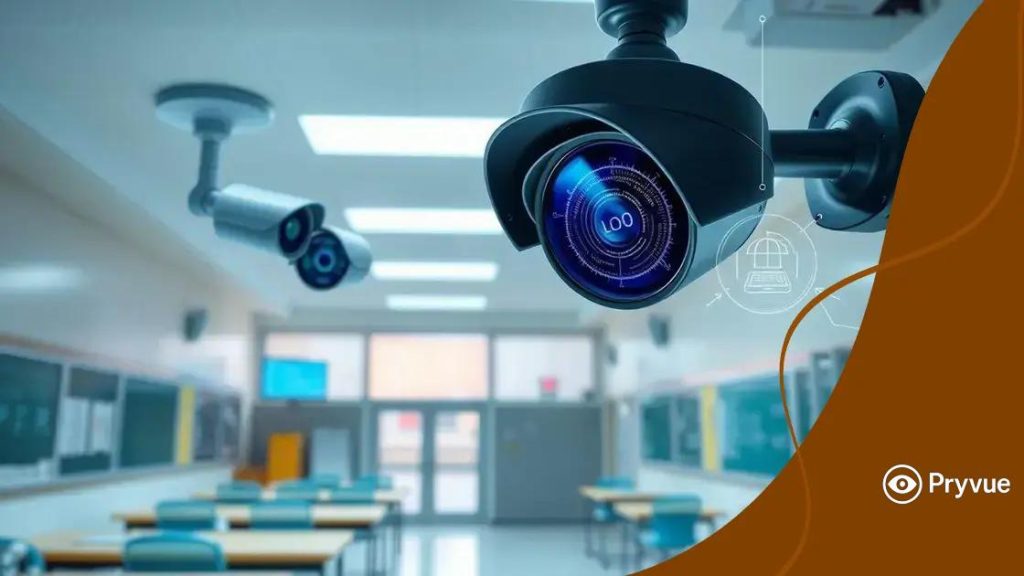Tech for safer schools in 2025: what to expect

Anúncios
Tech for safer schools in 2025 includes smart surveillance systems, AI-driven incident prevention, and active engagement of students and staff to establish a secure learning environment.
Tech for safer schools in 2025 could change how students experience learning environments. Imagine classrooms equipped with advanced safety measures that foster a sense of security. What changes can we expect as technology evolves?
Anúncios
Emerging technologies shaping school safety
Emerging technologies shaping school safety are creating new opportunities for secure learning environments. Schools are now focusing on innovative solutions to protect students and staff while encouraging a positive atmosphere.
Advanced Surveillance Systems
One breakthrough is the integration of advanced surveillance systems. These systems not only monitor entrances but can also analyze behaviors in real time. This technology allows schools to respond quickly to potential threats.
- Smart cameras with facial recognition
- Real-time alerts for unusual activity
- Data integration across school campuses
These surveillance systems work seamlessly with other safety measures. Furthermore, they provide actionable insights, making safety protocols more efficient.
Anúncios
Artificial Intelligence Innovations
Artificial intelligence is another game changer for school safety. AI can predict potential threat scenarios by analyzing data. For example, schools can identify patterns in behavior that may indicate trouble before it escalates.
Moreover, AI helps in emergency response planning. It can simulate various situations, enabling schools to prepare better and more effectively. By implementing AI, schools create a safer learning environment for everyone involved.
In summary, leveraging emerging technologies in school safety can significantly improve how schools manage security. From advanced surveillance to AI, these tools create a proactive approach to safety that benefits all stakeholders.
Benefits of smart surveillance systems
Benefits of smart surveillance systems are transforming the landscape of school safety. By integrating technology, schools can enhance their security measures significantly.
Enhanced Monitoring Capabilities
Smart surveillance systems offer enhanced monitoring capabilities that traditional systems cannot match. With features like real-time video streaming and automated alerts, schools can respond to incidents immediately. This proactive approach helps ensure the safety of students and staff.
- 24/7 coverage of school grounds
- Automatic tracking of movements
- Instant notifications of suspicious activity
The increased vigilance allows staff to focus on education while surveillance systems take care of security.
Data-Driven Insights
Another major benefit is the ability to gather data over time. Smart surveillance systems can analyze patterns of behavior, helping schools identify areas that may need additional attention. This data-driven insight can lead to improved safety protocols.
For example, if a certain area of the school shows a pattern of incidents, the administration can take steps to enhance security measures specifically in that location. Adapting to the data helps create a more secure environment.
Overall, the implementation of smart surveillance systems in schools not only enhances safety but also fosters a sense of security among students and parents. This technology paves the way for more effective safety strategies that evolve as needed.
The role of AI in preventing incidents

The role of AI in preventing incidents is becoming increasingly important in today’s educational environments. By utilizing advanced technologies, schools can create a safer atmosphere for students and staff.
Analyzing Behavior Patterns
AI systems are capable of analyzing behavior patterns to identify potential threats. These systems can process vast amounts of data quickly, allowing them to recognize anomalies and alert security personnel.
- Detection of unusual movements or crowd formations
- Early warning systems for potential violence
- Analysis of historical data for trend identification
This predictive capability enables schools to respond before incidents escalate, creating a proactive approach to security.
Enhancing Emergency Response
AI also enhances emergency response planning. For instance, AI can simulate various scenarios to help schools prepare for potential emergencies. This preparation includes creating efficient evacuation plans and resource allocation during a crisis.
Moreover, AI can assist in real-time communication during incidents. By providing timely updates, it ensures that all stakeholders are informed and can act accordingly.
Embracing AI technology in schools not only addresses potential threats more effectively but also supports a culture of safety and preparedness. As this technology continues to evolve, its integration into school safety protocols will be essential.
How digital infrastructure supports safety
How digital infrastructure supports safety is a crucial aspect of modern school security. With advances in technology, schools can utilize digital tools to enhance the safety of their environments.
Integrated Communication Systems
One significant benefit of digital infrastructure is the integration of communication systems. These systems allow for quick and effective communication during emergencies. When an incident occurs, alerts can be sent instantly to staff and law enforcement, ensuring a rapid response.
- Instant notifications through mobile apps
- Two-way radios for real-time communication
- Public address systems for announcements
This immediate communication helps coordinate responses and keeps everyone informed, reducing panic and confusion.
Centralized Data Management
Digital infrastructure also supports safety through centralized data management. Schools can collect and analyze data related to incidents, helping them to identify potential risks. Having access to this information allows schools to develop targeted safety measures based on real evidence.
For instance, by analyzing incident reports, schools can detect trends and adjust their security strategies accordingly. Digital tools can create reports that highlight areas needing attention, making decision-making more effective.
Overall, investing in digital infrastructure not only enhances communication and data management but also contributes significantly to creating a safer school environment. With these technologies, schools can proactively protect students and staff while ensuring a conducive learning atmosphere.
Engaging students and staff in safety protocols
Engaging students and staff in safety protocols is essential for fostering a safe school environment. When everyone feels involved, they are more likely to adhere to safety measures and be proactive in emergency situations.
Education and Training Programs
One effective way to engage both students and staff is through regular education and training programs. These programs can include workshops, drills, and informational sessions that cover safety protocols. By providing clear guidance, schools empower their communities to respond effectively to emergencies.
- Regular safety drills to practice procedures
- Workshops on recognizing warning signs
- Involvement of local law enforcement in training sessions
This understanding creates a culture of safety where everyone knows their role and responsibilities.
Creating a Safety Committee
Another strategy is establishing a safety committee that includes students, staff, and parents. This committee can assess current safety measures and propose improvements based on real feedback. Engaging students in this way gives them a voice in the safety process, making them feel valued.
The committee can host events to promote safety awareness and gather input from the school community. By encouraging collaboration, schools can develop safety protocols that resonate with everyone involved.
By actively involving students and staff in safety protocols, schools can improve the overall security environment. A shared commitment to safety not only protects individuals but also strengthens the sense of community within the school.
FAQ – Questions about safety in schools
How can smart surveillance systems improve school security?
Smart surveillance systems provide real-time monitoring and alerts, allowing for quick responses to potential threats.
What role does AI play in preventing incidents in schools?
AI analyzes behavior patterns to predict threats and enhance emergency response planning.
Why is digital infrastructure important for school safety?
Digital infrastructure helps centralize communication and data management, improving overall responsiveness during incidents.
How can students and staff be engaged in safety protocols?
Engaging students and staff through training programs and safety committees promotes awareness and responsibility in maintaining safety.